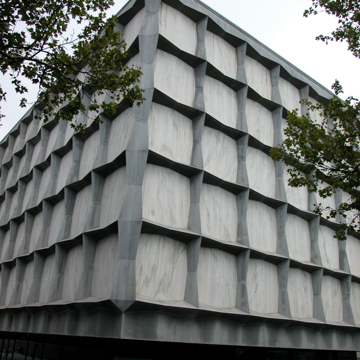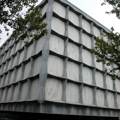The Beinecke Rare Book and Manuscript Library, designed by Pritzker Prize laureate Gordon Bunshaft of Skidmore, Owings and Merrill, houses Yale University’s collection of precious manuscripts, historical ephemera, and rare books, including a Gutenberg Bible. The building, which many observers have described as a jewel box, stands on the Hewitt Quadrangle next to Woodbridge Hall, Yale’s presidential office. Bunshaft himself considered the Beinecke Library central to his legacy: “It’s the only building I’ve been involved in that has an emotional impact.”
Prior to the Beinecke’s construction, Yale’s valuable tomes were stored at Sterling Memorial Library. Scholars could consult materials in the Rare Book Room, which lacked air conditioning and humidity control—inadequate conditions for preserving books. In addition, by the late 1950s, shelving space was scarce. University librarian James Babb and President A. Whitney Griswold secured funding for a new facility dedicated to rare books from Edwin J., Frederick W., and Walter Beinecke, three brothers who had attended Yale. (Walter Beinecke had passed away earlier, and his wife acted on his behalf.)
Paul Rudolph, chairman of the Yale School of Architecture, proposed a limited competition between a few chosen architects, one of them being Gordon Bunshaft. However, Bunshaft argued that a competition would not deliver the optimal outcome for the client’s needs. He explained his view to the university’s provost, who then assured him that the Yale Building Committee would select a candidate directly. Bunshaft and the Beinecke brothers had both collaborated with the Fuller Construction Company, and this connection helped the architect in securing the Yale commission.
Initially, Bunshaft wanted to use a tan-colored onyx for the windowless facade. An extensive search for a quarry that could provide a sufficient number of onyx sheets proved difficult and the architect settled on Danby marble from Vermont. Apart from the change in building material, the architect made only minor changes from the first scheme to the final design. Construction began in 1960 and the library was completed three years later.
The Beinecke library is constructed of Vierendeel trusses, which are elevated and supported by four steel corner columns sheathed in concrete and shaped like truncated pyramids. The Vierendeel frames are clad in Vermont Woodbury granite, white with gray veins, which showcases the structural composition of the building. These frames hold one-and-a-quarter-inch-thick, octagonal—almost square—marble panels in between them. The library is five encased marble elements high, ten deep, and fifteen wide. The recessed ground-floor level, where the entrance is located, is encased in a glass wall, and adds to the floating character of the large marble structure. The heavy box is counterbalanced by the negative space of a sunken courtyard in front of the building, where Japanese-American artist Isamu Noguchi created a sculpture garden.
While the exterior of the Beinecke Library might seem cold or stark, the interior glows in an amber-colored light during the day. This effect is reversed at night, when the building shines from within. The marble panels filter the sunlight so that damaging ultraviolet rays are blocked out, preserving Yale’s rare books. About 180,000 of these volumes are housed in a six-story-high glass tower in the center of the building. Their colorful spines are visible from outside this temperature- and humidity-controlled enclosure, which seems to carry the weight of the building.
The ground floor and a second-floor mezzanine level provide exhibition space and are connected by two staircases opposite each other. The basement provides additional storage space for more than a million volumes, as well as reading rooms, seminar rooms, and offices.
The light source for the basement spaces is Noguchi’s sculpture garden. Although Bunshaft and Noguchi were both strong-minded individuals, they successfully collaborated on numerous occasions. Noguchi’s sculptures for Beinecke consist of three marble forms resting on an incised marble plane: a pyramid, representing earth; a donut-shaped sun, alluding to the source of life; and a cube perilously balanced on one corner, illustrating chance. According to Bunshaft, Noguchi was inspired by ancient astronomical viewing structures in Jaipur, India.
Beinecke library’s modern design departs from the surrounding Yale buildings, which range in architectural style from neo-Gothic (the Law School and Berkeley College) to neo-Classic (University Commons, Woolsey Hall, Woodbridge Hall, and the two secret society buildings, Book and Snake and Scroll and Key). However, Bunshaft did consider the library’s setting on the vast granite plaza and its relation to the adjoining structures. For instance, Beinecke’s roof and the cornice of University Commons are aligned, and the library is positioned diagonally across from Woodbridge Hall, with their entrances echoing one another. As Patrick Pinnell notes, Beinecke follows the long tradition of inward, closed-box architecture at Yale.
There are several popular myths surrounding Beinecke library. One rumor has it that the building can serve as an underground shelter in case of a nuclear attack, in which case the structure would sink into the ground. This is not true. While Bunshaft incorporated forward-thinking technologies with the library’s purpose in mind, the structure is, as the architect called it, a “huge vault” whose exterior alludes to the treasures stored inside.
The library was renovated in 2015–2016, with updates made to the building’s mechanical systems and expansion of its teaching and research facilities. During the renovation, a temporary reading room was opened at the Sterling Memorial Library across Wall Street.
References
Adams, Nicholas. “Beinecke Library as an Architectural Manifesto.” Casabella 761/762 (December 2007–January 2008): 30–43, 168–170.
Brown, Elizabeth Mills. New Haven: A Guide to Architecture and Urban Design. New Haven: Yale University Press, 1976.
“Bunshaft and Noguchi: An Uneasy But Highly Productive Architect-Artist Collaboration.” AIA Journal 65, no. 10 (October 1976): 52–55.
Kidder Smith, G.E. Sourcebook of American Architecture. New York: Princeton Architectural Press, 1996.
Krinsky, Carol Herselle. Gordon Bunshaft of Skidmore, Owings & Merrill. New York: Architectural History Foundation, and Cambridge: MIT Press, 1988.
Parks, Stephen, ed. The Beinecke Library of Yale University. New Haven, CT: Beinecke Rare Book and Manuscript Library (University Press of New England), 2003.
“Rare Book Box.” Architectural Review 135, no. 808 (June 1964): 391–392.
Tidmarsh, David. “Myths abound about Beinecke.” Yale Daily News blog. February 04, 2010. http://yaledailynews.com/.
“Yale’s New Vault: Material/Structural Analysis.” Progressive Architecture 42 (December 1961): 152–159.

























